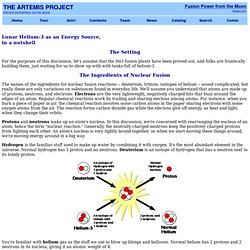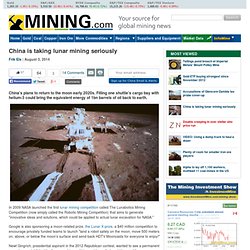

Twitter. Artemis Project: Lunar Helium-3 as an Energy Source, <br>in a nutshell. Lunar Helium-3 as an Energy Source, in a nutshell The Setting For the purposes of this discussion, let's assume that the He3 fusion plants have been proved out, and folks are frantically building them, just waiting for us to show up with with tanks full of helium-3.

The Ingredients of Nuclear Fusion The names of the ingredients for nuclear fusion reactions -- deuterium, tritium, isotopes of helium -- sound complicated, but really these are only variations on substances found in everyday life. We'll assume you understand that atoms are made up of protons, neutrons, and electrons. Protons and neutrons make up an atom's nucleus. Hydrogen is the familiar stuff used to make up water by combining it with oxygen. You're familiar with helium gas as the stuff we use to blow up blimps and balloons.
Now, if you kick out one of neutrons, you get helium-3. He3 casts lustful eyes upon that neutron in the deuterium, and will grab it if it gets a chance. The Mixture This is a nuclear fusion reaction. Mining the Moon. At the 21st century’s start, few would have predicted that by 2007, a second race for the moon would be under way. Yet the signs are that this is now the case. Furthermore, in today’s moon race, unlike the one that took place between the United States and the U.S.S.R. in the 1960s, a full roster of 21st-century global powers, including China and India, are competing. Even more surprising is that one reason for much of the interest appears to be plans to mine helium-3–purportedly an ideal fuel for fusion reactors but almost unavailable on Earth–from the moon’s surface. NASA’s Vision for Space Exploration has U.S. astronauts scheduled to be back on the moon in 2020 and permanently staffing a base there by 2024.
While the U.S. space agency has neither announced nor denied any desire to mine helium-3, it has nevertheless placed advocates of mining He3 in influential positions. This Moon was Made for Mining (Helium-3) The 2009 indie film Moon features Sam Rockwell as an employee (named Sam) of the fictional Lunar Industries, a mining corporation back on Earth.

Just wrapping a three-year solitary stint on the moon, Sam is charged with overseeing the automated harvesters which extract helium-3 from the lunar regolith. Canisters of the harvested helium-3 are then sent to Earth to be used to generate fusion energy. Much of the film deals with Sam’s growing personal crisis as he finds out a few unpleasant things about his employer. The movie’s premise is technically science fiction, but the notion of mining the moon for valuable natural resources that are in short supply on Earth is closer to reality than you might think.
Helium-3. Helium-3 (He-3) is a light, non-radioactive isotope of helium with two protons and one neutron.

It is rare on Earth, and it is sought for use in nuclear fusion research. The abundance of helium-3 is thought to be greater on the Moon (embedded in the upper layer of regolith by the solar wind over billions of years),[1] though still lower in quantity (28 ppm of lunar regolith is helium-4 and from one ppb to 50 ppb is helium-3)[2][3] than the solar system's gas giants (left over from the original solar nebula). Helium-3 was hypothesized to be a radioactive isotope until helions were also found in samples of natural helium, which is mostly helium-4, taken both from the terrestrial atmosphere and from natural gas wells.
This was done by Luis W. Alvarez and Robert Cornog in cyclotron experiments at the Lawrence Berkeley National Laboratory in California in 1939.[5] Physical properties[edit] [edit] Neutron detection[edit] n + 3He → 3H + 1H + 0.764 MeV Cryogenics[edit] Medical lung imaging[edit] Mining the Moon. China is taking lunar mining seriously. China's plans to return to the moon early 2020s.

Filling one shuttle's cargo bay with helium-3 could bring the equivalent energy of 1bn barrels of oil back to earth. In 2009 NASA launched the first lunar mining competition called The Lunabotics Mining Competition (now simply called the Robotic Mining Competition) that aims to generate "innovative ideas and solutions, which could be applied to actual lunar excavation for NASA. " Google is also sponsoring a moon-related prize, the Lunar X-prize, a $40 million competition to encourage privately funded teams to launch "land a robot safely on the moon, move 500 meters on, above, or below the moon’s surface and send back HDTV Mooncasts for everyone to enjoy! " Newt Gingrich, presidential aspirant in the 2012 Republican contest, wanted to see a permanent moon base established by the second term of his presidency that could be used for space tourism and mining ventures. It does, however, exist on the moon.